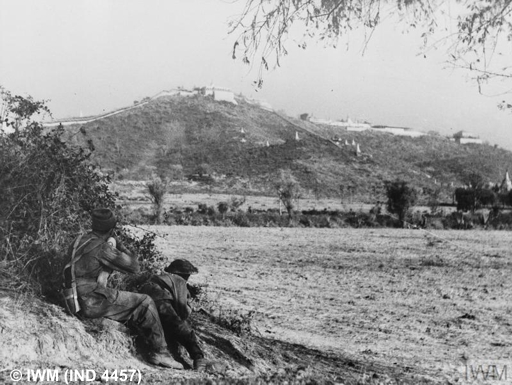Attack on Fort Dufferin, 10th March 1945
At 06:15 on the morning of 8th March 1945, a British/Indian mobile column burst into the northern outskirts of Mandalay and seized the northern slopes of the pagoda-topped Mandalay Hill. The column, known as ‘Stiletto Force’, took the Japanese defenders completely by surprise, scattering them into small groups as it advanced.[1] In the wake of ‘Stiletto Force’ was the infantry of the 98th Indian Infantry Brigade and units from this formation were the first of the follow-up troops to reach the northern outskirts of the city. In the van was the 8th Battalion, 12th Frontier Force Regiment (8th/12th F.F. Regiment), which arrived at around 14:00 that afternoon. Thrown into disarray the Japanese were unable to organise a response until later that evening, when they began shelling Mandalay Hill.[2]
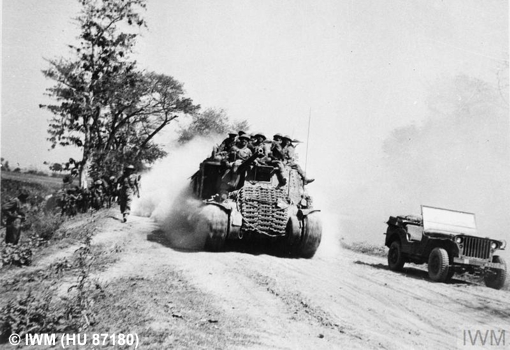
Tanks with infantry speeding along the road to attack a village near Madaya, 12 miles north of Mandalay, March 1945.
The British and Indian troops involved were all under the command of the 19th Indian Infantry Division which formed the northern pincer of the XXXIII Corps advance to Mandalay. The other two divisions of the Corps, the 20th Indian and the 2nd British, formed the western pincer, aiming primarily to cut off the Japanese line of retreat to the south and east of Mandalay. During the night of 8th/9th March, the 98th Indian Infantry Brigade began its assault on the city. On the morning of 9th March, the 4th Battalion, 4th Gurkha Rifles seized the northern and higher of the two peaks of Mandalay Hill. By now the Japanese had recovered from their shock and were ready to counter attack. The Gurkhas on Mandalay Hill, supported by M3 Lee tanks of the 150th Regiment, Royal Armoured Corps (R.A.C.) firing from the road along the foot of the hill, fought off two counter attacks during the day. They encountered fierce resistance as they mopped up snipers hiding among the trees, rocks, deep caves and bunkers on the hillsides.
While this was going on, the 8th/12th F.F. Regiment advanced southwards until it reached the northern wall of Fort Dufferin (Mandalay Palace). It had been hoped to catch the Japanese unawares and take one of the entrances to the fort before a defence could be organised. However, as the 8th/12th F.F. Regiment approached the north wall, it found the moat full of water, the two bridges wired but not mined and the immensely thick walls of the fort undamaged by bombing. Worse, any attempt to approach the moat in daylight was met by enemy small arms fire. As more troops arrived to bolster the 98th Indian Infantry Brigade, plans were made for an assault on the North Gate the next morning, 10th March. Once the wall had been breached near the North Gate by a medium gun firing over open sights, the 8th/12th F.F. Regiment was to break into the fort under the cover of an intensive artillery bombardment and supported by tanks.[3]
Many of these events were captured in photographs and on film by the many official reporters and cameramen accompanying the 19th Indian Infantry Division. Indeed, there were so many cameramen that the author of the ‘dopesheet’ accompanying British film footage noted that the battle for Mandalay was “…covered by cameramen of almost all the nations of the world except the enemy.” [4] Several photographs in the Imperial War Museum Collection show the advance of Indian troops and supporting tanks into Mandalay on 10th March. The collection also holds photographs of British medium artillery firing at the walls of Fort Dufferin. Dramatic newsreel footage, taken by British and American cameramen, shows tanks and infantry advancing past Mandalay Hill and conducting what is almost certainly the attack on the North Gate of Fort Dufferin by the 8th/12th F.F. Regiment on 10th March. The British footage, taken by Lieutenants Hayat and Abbas, is held by the Imperial War Museum. It is raw, unedited footage without sound or narration.[5] The American newsreel, included as part of ‘Combat Bulletin #48’, produced by the American Signal Corps, Army Pictorial Service, is accompanied by a dramatic narration, typical of the period.[6] Both films show British and Indian troops and tanks passing to the west of Mandalay Hill and southwards to the outskirts of Mandalay city. The footage then cuts to the bombardment of one of the walls of Fort Dufferin by a British 5.5-inch gun (not a 4.5-inch gun as described in the American newsreel). The British film then appears to capture the artillery bombardment which preceded the infantry advance, one shell landing perilously close to the cameraman’s position. Following this, Indian troops, supported by British and Indian tanks, can be scene advancing towards the moat near one of the gates to the fort. By now, the pavilion or ‘pya-that’ above the gate has been set ablaze. Two M3 Lee tanks can be seen on the right flank of the attack from where they can fire into the gate at an angle, direct observation and fire into the gateway being prevented by the protective masonry barbican. In the American newsreel, a Stuart light tank is seen following up behind one of the Lee tanks. Later, the Indian infantry are seen taking cover in dead ground as smoke obscures them from the view of the Japanese defenders. The narration to the American newsreel claims that “…several of our tanks are knocked out….”, but as we shall see this was not the case.
A Note on the Films and Photographs
The American newsreel, ‘Combat Bulletin #48 is in the public domain and available to view from several sources (see endnotes). The best quality version is available on You Tube; see: “Combat Bulletin No. 48”, YouTube, and go to 21:52 minutes.
The unedited British/Indian film is held by the Imperial War Museum. I am grateful for the kind permission of IWM Film to link to the film in full and to include stills from the film with this article. To view the footage, please follow this link: IWM Film, reference JIN 16. Stills from the film are credited individually.
Many photographs were also downloaded from the main Imperial War Museum Collections site and are also credited individually.
Identifying the Action Depicted
That the action depicted in the IWM footage captures the attack by the 8th/12th F.F. Regiment on 10th March is supported by the notes which accompany the IWM film, which give a production date of 10th March 1945. There is no date attached to the American film. That both films record the attack of 10th March may, however, be surmised by comparing what is portrayed with the various attempts to enter the fort between 9th March and the eventual entry of the British and Indian troops on 20th March. It will be seen that no other attempt to gain entry to the fort matches the images:
- The first action against the fort was on the afternoon of 9th March, when the 8th/12 F.F. Regiment undertook what might be described as reconnaissance in force towards the north wall. It was thought that entry to the fort might be gained at a rush, with the Japanese defenders being caught unprepared. However, this hope was dashed when it was found that entry to the fort was blocked and covered by Japanese small arms fire. This attack was not supported by medium artillery and was called off when the Japanese launched a counter attack from the southern end of Mandalay Hill. This enemy attack was broken up by defensive artillery fire.
- The action on 10th March involved a full blown multi-company infantry assault on the north gate, supported by tanks and artillery. It was preceded by an attempt to breach the north wall of the fort by direct artillery fire from a British medium 5.5-inch gun. Once the breaches had been made, an artillery bombardment preceded the advance of the infantry and supporting tanks. This action will be described in detail below.
- Actions on 11th and 12th March were confined to clearing the area around Fort Dufferin and the fighting to clear Mandalay Hill. The 8th/12th F.F. Regiment was involved in clearance operations around Fort Dufferin. At the request of the Battalion Commander, Lt. Colonel Sheik, a 5.5-inch howitzer from 498 Battery, 134th Medium Regiment, R.A., was brought up to bombard the north wall, and more guns were brought up over the following days. No attacks were launched against the fort during this period.
- Further breaches were made in the north wall by the medium howitzers on 13th March. Two Thunderbolts bombed the bridge on the south side of the moat, across from the 8th/12th F.F. Regiment positions, but the infantry did not make an attack, instead confining their activities to patrolling the area north of the moat. The 1st Battalion, 6th Gurkha Rifles attacked the area to the south west of the fort, supported by tanks and artillery, but was stopped by gun fire which damaged their tanks.
- Operations continued to clear the area around the fort and to probe for Japanese weak points. On 15th March, the 98th Indian Infantry Brigade was relieved by the 64th Indian Infantry Brigade. The 8th/12th F.F. Regiment came under the temporary command of the new brigade. By now all exits from the fort had been blocked. Further breaches were made but the impact of the shells was lessened by the thickness of the walls and the earth embankments piled up behind them. More breaches were made on 16th March, the fire of the medium guns being interrupted only by air-strikes against the wall.
- On the night of 16th/17th March, the 8th/12th F.F. Regiment launched a night attack across the moat, using boats to cross the water from the north east corner. All went well at first but near midnight the Japanese defenders started firing and it was obvious that surprise had been lost. Attempts were made to rush the breaches but it was then discovered that they were all manned by the Japanese and all attempts to enter the fort failed. The troops were withdrawn early on the morning of 17th March. A simultaneous night attack by the 1st Battalion, 15th Punjab Regiment on the north-west corner of the fort met with a similar fate.
- Further attempts to cross the moat by boats were made by other battalions on 18th March, in the area of the eastern gate, at the south wall and from the west. All these attacks were held.
- The Indian Official History describes 19th March as “the big gun-day of the siege of Dufferin”, with four 6-inch and two 5.5-inch guns being used to blast the walls at ranges of between 300 to 500 yards. There were no infantry assaults against the fort this day.
- There was further bombardment of the walls on the morning of 20th March. The guns were interrupted by air strikes by B-25 Mitchell medium bombers and Thunderbolts. Following these air strikes, several Anglo-Burmans came out of the North Gate, carrying a white flag and a Union Jack. They reported that the Japanese had moved out through the sewers during the night. The 1st Battalion, 15th Punjab Regiment then entered the fort from the north at about 13:30. The Japanese had indeed left, leaving behind large quantities of supplies. The siege of Fort Dufferin was over.[7]
It seems therefore that the action which fits most closely with that captured in the newsreels is that of 10th March, when the 8th/12th F.F. Regiment attacked the North Gate in daylight. It is this action which will now be described in detail, accompanied by photographs and stills captured from the newsreels.
The Approach and First Attack: 8th-9th March 1945
During 8th March 1945, the 4th Battalion, 4th Gurkha Rifles established two companies on the summit of Mandalay Hill, having killed 27 Japanese in the assault and subsequent clearance operations. The 98th Indian Infantry Brigade was ordered to patrol as far south as the line of the north moat of Fort Dufferin during the night of 8th/9th March, and to the line of the south moat by first light on 9th March. If the fort and the area around it were found to be unoccupied or lightly held they were to be taken. ‘Stiletto Force’, then under the command of the Brigade, was to revert to the direct command of 19th Division Headquarters at 09:00 on the morning of 9th March. By the evening of 8th March, the 8th/12th F.F. Regiment was established in the northern outskirts of Mandalay, just to the west of Mandalay Hill. Battalion Headquarters and ‘D’ Company spent the night in the area of Obo railway station (marked ‘Obo R.S.’ on the map) with ‘A’ and ‘B’ Companies forward to the south where they formed a box in the area of Linzin, to the west of the racecourse and about a mile and half from the north wall of Fort Dufferin. [8]
At 07:00 the next morning, patrols from 'A' and 'B' Companies were sent south to the area of the fort. A report was received at 09:00 that no enemy had been seen in the area of the fort walls but a section of Japanese soldiers coming from the cemetery area had been encountered and fired upon by the patrols. Three Japanese were killed.[9]
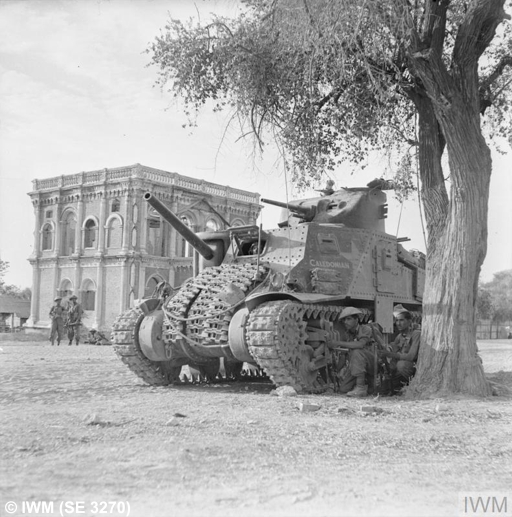
'Caledonian', an M3 Lee of 'C' Squadron, 150th Regiment, R.A.C., supporting infantry of the 19th Indian Division, Mandalay 9th-10th March 1945.
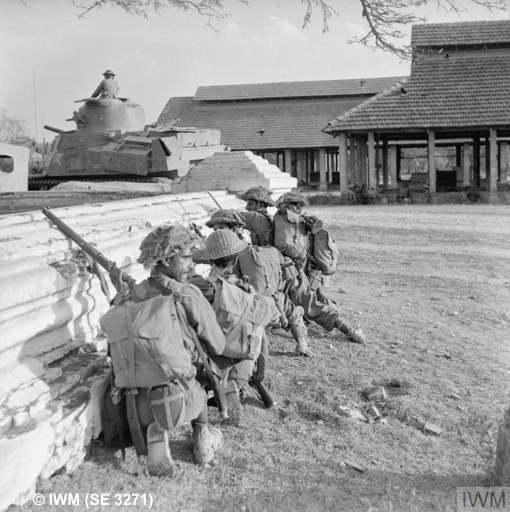
Indian troops, possibly from the 8th Battalion, 12th Frontier Force Regiment, supported by an M3 Lee of 'C' Squadron, 150th Regiment, R.A.C., advance cautiously into the outskirts of Mandalay, 9th-10th March 1945.
That afternoon, the 8th/12th F.F. Regiment mounted a probing attack in an attempt to gain entry to Fort Dufferin via the North Gate. At 14:00, No.s 1 and 2 Troops from 'C' Squadron, 150th Regiment, R.A.C., equipped with American M3 Lee tanks, under the command of the Squadron second-in-command, Captain Hobson, were ordered to support the attack. The tanks were accompanied by two platoons of the 3rd Battalion, 4th Bombay Grenadiers in the close protection role. 'B' and 'D' Companies moved toward the fort and took up positions in the area west of the pre-war Sappers and Miners Lines [at 596684]. 'A' Company moved to the Police Station (marked 'P.S' on the map) in the area of 587687 with 'C' Company' in reserve in the area of Obo village.
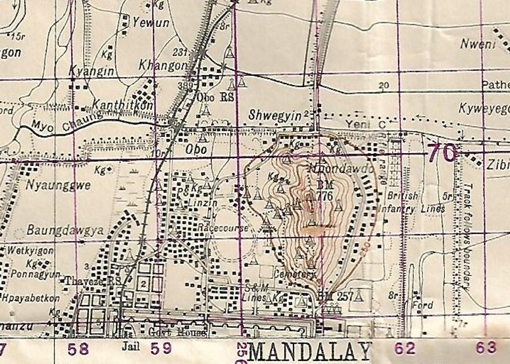
Map of northern Mandalay (sheet 93 B-4) showing: Mandalay Hill; the racecourse; the Sappers & Miners Lines; the north wall of Fort Dufferin. (Simon Jervis Collection).
The attack began at 16:45 with the forward companies sending out patrols to seek out the enemy. At 17:00, patrols from 'A' Company reported that a Japanese detachment of about platoon strength had been seen holding the east-west line through Thayeze railway station to the area around the Buddhist ‘kyaung’ or monastery (marked 'Kg' on the map) at 579684. The enemy were thought to have a least three machine guns and a grenade discharger. Then, 'B' Company pushed patrols forward to the road running east-west on the north side of the fort moat. Signs were observed suggesting that the approach to the fort was heavily mined. The bridge was observed by Corporal Paul of the 150th Regiment, R.A.C., commanding tank '1B', from a distance of about 20 yards and he reported that it did not appear suitable for tanks. The infantry patrols now came under sniper fire from the walls of the fort. Then, a patrol to the east of the main 'B' Company position reported that an enemy infantry detachment with an infantry gun, believed to be a 75mm, was advancing westwards from the southern end of Mandalay Hill towards the 'B' Company position. A heavy artillery barrage was brought down on this detachment and the tanks were called forward. Fire was exchanged with the Japanese in an engagement that the 150th Regiment, R.A.C. war diary describes as “hot”. The enemy brought the tanks under mortar fire and they got off at least one shot from the accompanying gun. The Japanese were then seen to disperse, abandoning the infantry gun, but not before they had scored a hit on the forward suspension of one of the Lees. Fortunately, no serious damage was done and the hit was only discovered after the action. Given this enemy activity and the approach of darkness, the attack was called off. Casualties from 'B' and 'D' Companies were then evacuated and a defensive box was established 200 yards north of the fort, at which point the tanks withdrew into harbour. Food and ammunition were brought up under escort to the two companies. At 18:00, harassing artillery fire was laid down on the area of the fort just inside the North Gate road bridge. Sniping continued in the rear of the 8th/12th F.F. Regiment, especially at the road junction to the west of the racecourse. Later that evening, at 23:00, an engineer patrol set off to undertake a reconnaissance of the bridge over the moat.[10]
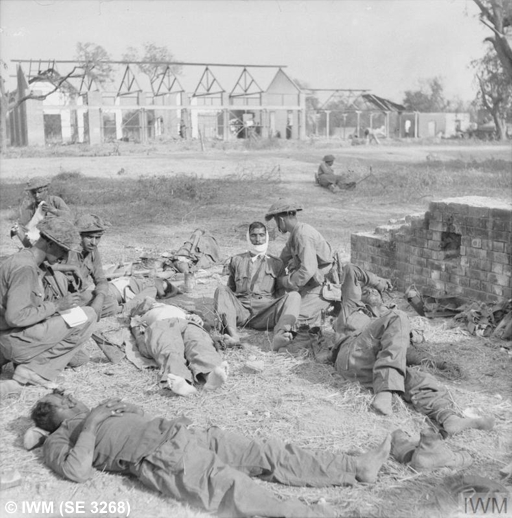
Wounded Indian troops, possibly of the 8th Battalion, 12th Frontier Force Regiment, being treated prior to evacuation, Mandalay, 9th-10th March 1945.
The Attack of 10th March 1945
The Headquarters, 19th Indian Infantry Division now ordered the 98th Indian Infantry Brigade to capture Mandalay by last light on 10th March. Operations were to begin no later than 10:00 that morning. The Brigade made ready to carry out these orders and issued its own instructions late on 9th March, confirming that the object of operations on 10th March was the clearance of the whole of Mandalay city. Two of the Brigade’s battalions would be in action that day, with one in reserve. The tasks given to the 8th/12th F.F. Regiment were the clearance of Fort Dufferin and of an area outside of the fort. From local reports, it was thought that the fort was held by around 50 Japanese. A field regiment of 25-pounder guns was allotted to support the 8th/12th F.F. Regiment, together with a troop of M3 Lee medium tanks from the 150th Regiment, R.A.C. and a troop of Stuart light tanks of the 7th Light Cavalry. A medium regiment, 134th Medium Regiment, R.A., was to be on call to support either of the active battalions. Each active battalion was also supported by a troop of the 275th Anti-Tank Battery and a platoon of engineers from the 64th Field Company, R.E. The 4th Battalion, 4th Gurkha Rifles was the other active battalion while the 2nd Battalion, Royal Berkshire Regiment formed the Brigade reserve.[11]
Although built in another age, the fort remained an excellent defensive structure and, if defended, would prove very difficult to storm. It had been built to secure the palace of King Mindon when he established his capital in Mandalay in 1858, It was renamed by the British after the Earl of Dufferin who was viceroy of India when north Burma was annexed in 1886. Today it is known as Mandalay Palace and has been largely restored. The British Official History describes Fort Dufferin as:
“.. a walled enclosure one mile square, which contained government offices and houses and the Mandalay railway station. It was surrounded by a forty-foot wide moat bridge in five places [two of these allowing the entry/exit of the railway]. The wall, some twenty-three feet high, was constructed of brick banked up on the inner side by an earthen ramp and buttressed every 300 feet. It was some 30 feet thick at the base, narrowing to about twelve feet at the top, along which there was a walk protected by a crenellated brickwork superstructure several feet thick. The gates in the centre of each wall were set at an angle to the bridge leading to them and defiladed by massive buttresses. It was a fortress of great strength.”
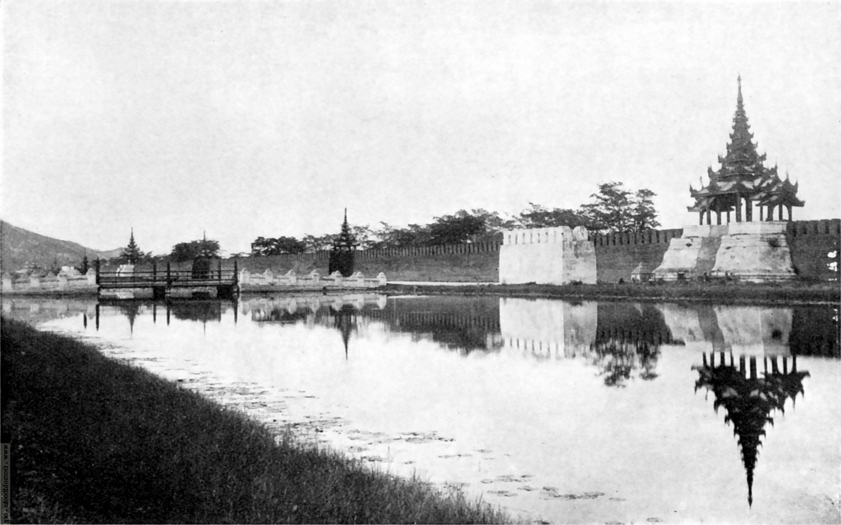
A pre-war photograph of Fort Dufferin, the moat, bridge and North Gate, with Mandalay Hill appearing in the background to the left. Note the masonry screen or barbican protecting the gateway.
Over each gate was constructed a wooden many-tiered pavilion or ‘pya-that’. The one above the North Gate caught fire during the attack on 10th March and it can be seen burning in the newsreel footage. The buttresses, masonry screens or barbicans that protect each gate are placed a few yards away from the moat in front of the gateway entrance. They are around 17 feet thick and served as an advanced defence work protecting both the gate and the bridge a few feet away. They also served to prevent a direct line of sight to the gateway.[12]
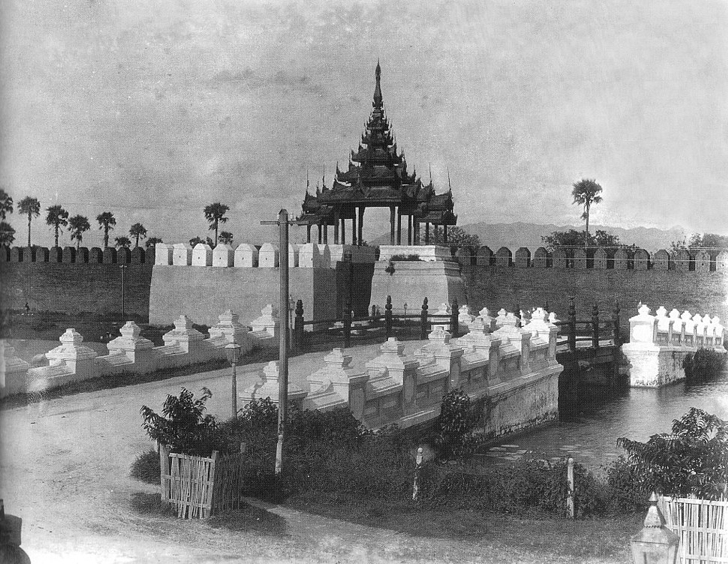
One of the gates to Fort Dufferin. If not the North Gate then this image gives a clear idea of what the attacking troops faced. Note the wooden centre to the bridge which was blocked by wire and also the barbican which prevented direct observation and fire into the gateway. The wooden structure above the gateway itself is a 'pya-that'. (“Burmah: a photographic journey, 1855-1925”, Singer N.F., Kiscadale (1993)
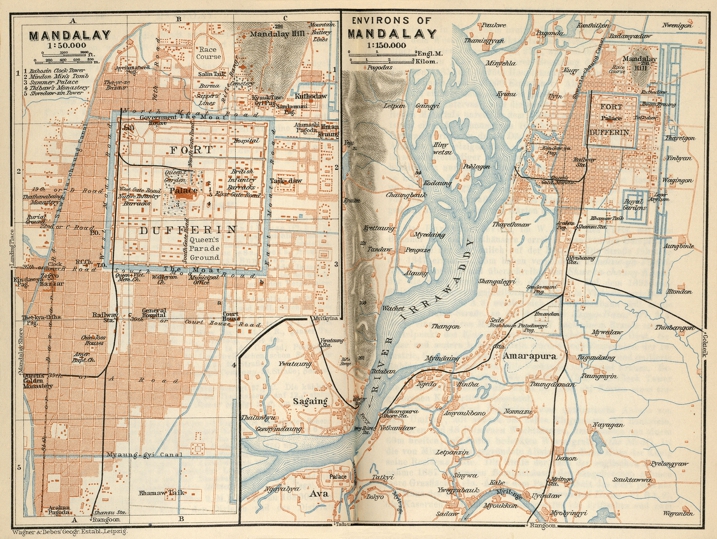
Map of Mandalay and its environs, 1914. ("Indien: Handbuch Für Reisende" published by Verlag von Karl Baedeker in Leipzig, 1914, courtesy of the Perry-Castañeda Library, University of Texas)
Click image to open full size in new window
The 8th/12th F.F. Regiment had spent a relatively quite night in defensive positions just to the north of the fort. The engineer patrol sent to examine the bridge over the moat opposite the North Gate returned at 03:30 and reported on what had been found. The bridge was of wooden construction and was blocked by a wire barricade. While it did not appear to be mined, as at first suspected, it was thought that the bridge would not support the weight of tanks. Where the road across the bridge reached the opposite side, it was observed to bend to the left and then to the right before entering the fort, navigating around the screening barbican which shielded the gate. It was noted that the barbican prevented direct observation and fire through the gate into the fort. The moat was estimated to be about 40 feet wide and of unknown depth. The only crossing point was by way of the bridge. A second bridge carried the railway line into the fort at its north east corner but was thought to be damaged and inaccessible.[13]
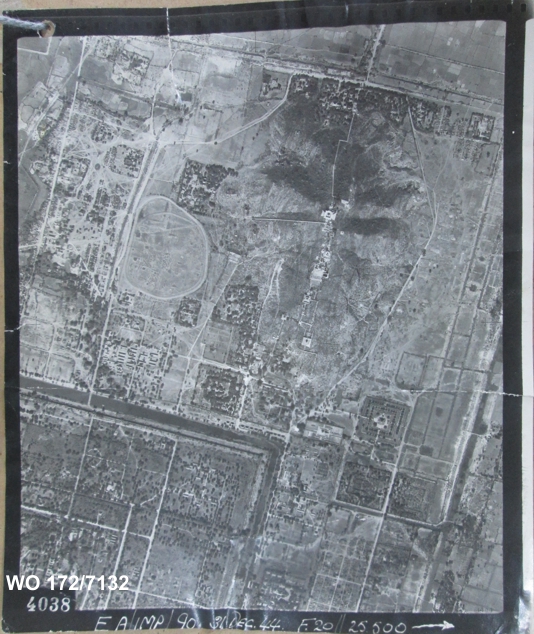
An aerial reconnaissance photograph of northern Mandalay, taken 31st December 1944. Clearly seen are: Mandalay Hill (top centre); the racecourse (to the left/west of the hill); the road leading to Fort Dufferin; the north moat and bridge across to the North Gate. (War diary 98th Indian Infantry Brigade, WO 172/7132.
Click image to open full size in new window
By 07:30 that morning, 10th March, the 8th/12th F.F. Regiment had made a plan to enter the fort across the bridge at the North Gate. The attack would begin with a bombardment by a 5.5-inch medium gun, provided by the 498th Battery, 134th Medium Regiment, R.A., firing over open sights directly at the walls of the fort. The intention was to create four breaches on the west side of the gate and to its right from the viewpoint of the attacking troops. Following the breaching of the wall, there would be an artillery barrage on the area just inside the fort wall. Smoke would also be laid to conceal the attacking troops as they approached, crossed the bridge and entered the fort through the breaches. A second company was then to pass through the first company and secure a firm box inside the fort. If this succeeded, the remaining two companies would follow through. 'D' and 'C’ Companies were selected to lead the attack. The tank support was provided by the M3 Lees of No.1 Troop from 'C' Squadron, 150th Regiment, R.A.C., under the command of Lieutenant Sharp, and a half squadron from 'C' Squadron, 7th Light Cavalry, consisting of No.s 1 and 3 Troops under the command of Captain Moody. Timed to coincide with this attack so as to minimise enemy interference on the left flank, to the east, other units of the 98th Indian Infantry Brigade were to attack Mandalay Hill and down to the cemetery area to the west of the hill.[14]
At 08:00, Battalion Headquarters and 'C' Company moved up to the area around 200 yards to the north of 'B' and 'D' Companies. At 10:00, a medium gun arrived and was positioned to begin firing at the walls of the fort. While this bombardment continued, the Battalion mortars ranged on the area east of Government House, to the west of the North Gate, as well as on the east side of gate. With the range established, the mortars would be ready to bring down smoke on these areas to offer some cover for the attackers. By 13:15, the medium gun had made four breaches in the wall, sufficient to for men to scramble over and through them. Air observation reported that on the far side of the wall there was a gradual slope down from the wall into the inside of the fort. Throughout this period, there was no enemy fire from the fort or its immediate area. At 13:20, the time for the attack was set for 13:55. This seems to have been later than expected as subsequently the war diary of the 98th Indian Infantry Brigade recorded that the attack by the 8th/12th F.F. Regiment was delayed due to the late arrival of the medium gun. Such a delay was thought to be "…inevitable when complicated operations are staged at short notice."[15]
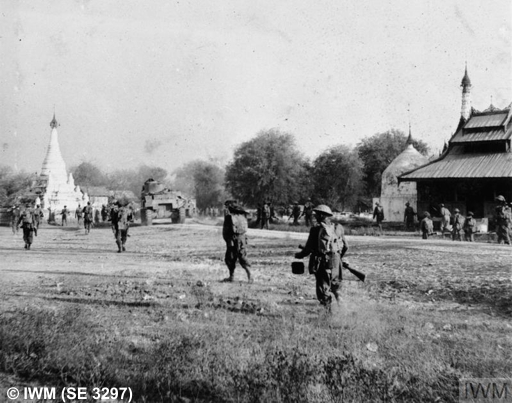
Indian troops, most likely of the 8th Battalion, 12th Frontier Force Regiment, supported by Lee tanks of the 150th Regiment, R.A.C., advance into Mandalay, 10th March 1945.
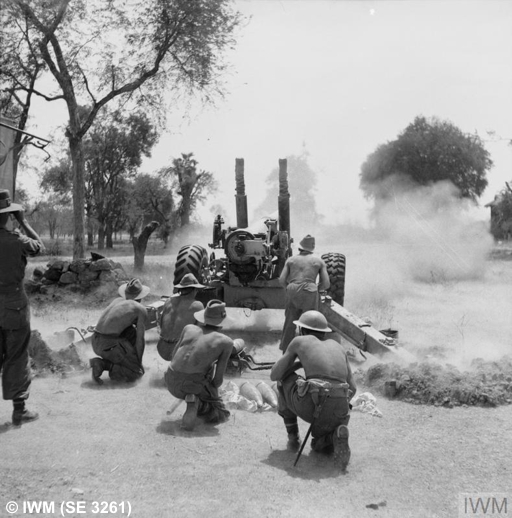
A British 5.5-inch medium howitzer firing over open sights at the north wall of Fort Dufferin, Mandalay, 10th March 1945.
Ten minutes before the attack began, an intense artillery concentration was laid down all around the fort gate and mortars began to lay smoke on the flanks as planned. Three minutes before the assault, 'D' Company moved up to begin the attack. 'C' Company then moved up on their left (to the east). Two troops of tanks had been allocated to give covering fire and these also moved up. As the attack went in, tank '1A' of No. 1 Troop, 150th Regiment, R.A.C. was pushed out to the right, along the east-west road running to the north of the moat, with the intention of obtaining an angle from which it could fire into the gate and along the walls from that flank. By now the 'pya-that' above the North Gate was on fire. The Stuarts of No.1 Troop, 7th Light Cavalry moved forward to protect the left flank.[16] The Japanese now opened up with machine gun fire from the area of the bridge and from the fort walls. 'D' and 'C' Companies were pinned down by this fire, but some of 'D' Company managed to get onto the bridge and started to remove the wire. Some of the enemy fire appeared to be coming from positions previously unidentified. The Lee tanks fired at the fort walls with their 75mm guns and machine guns in an attempt to suppress the Japanese fire.[17] [18]
Aerial reconnaissance photo taken during the battle for Fort Dufferin (dated 15th March 1945). Note the width of the strip of ground between the moat and the walls of the fort. The accounts suggest that some Japanese defenders occupied positions on this strip of land as well as behind the battlements up on the walls. Note also the earth rampart behind the walls inside the fort. The rampart would have strengthened the walls, making them more resistant to artillery fire and bombing. (Photo: Simon Jervis Collection)
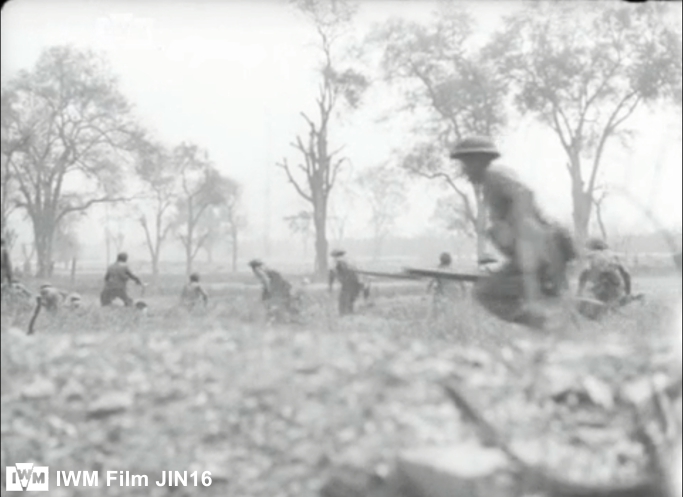
After the artillery bombardment, infantry of the 8th/12th F.F. Regiment advance cautiously towards the moat and the bridge, 10th March 1945. These are most likely the men of the 'D' Company who were the lead unit.
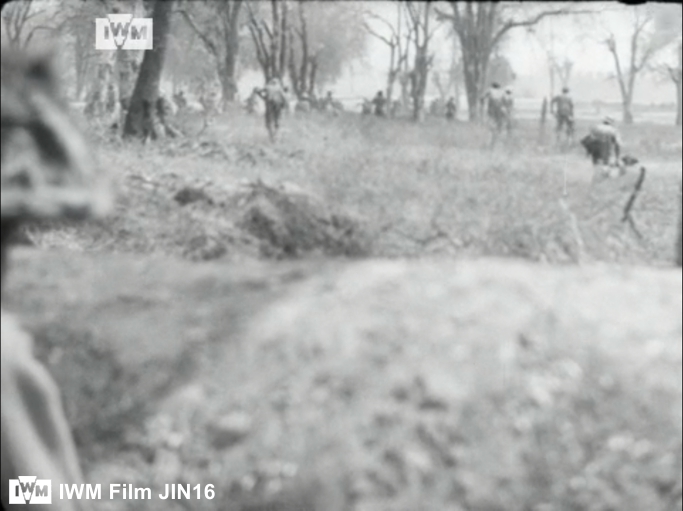
The troops advance steadily, crouching as they do so and staying within the wooded area in front of the moat.
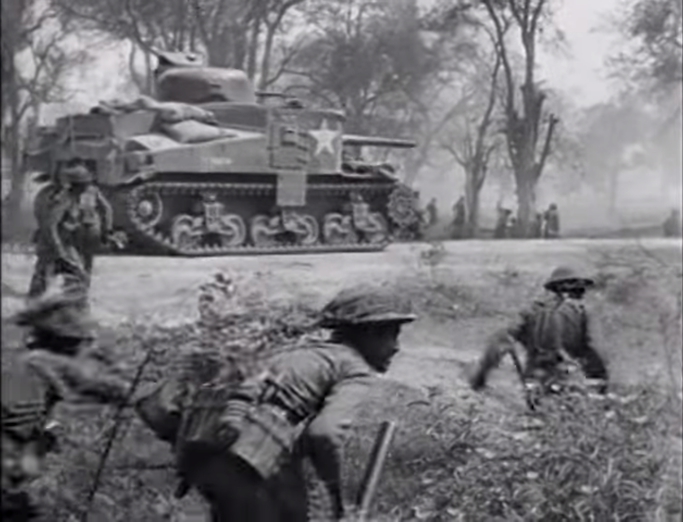
Close behind the lead assault troops, Lee tanks from 'C' Squadron, 150th Regiment, R.A.C, drive up to support the attack. They are accompanied by more infantry, including members of 'A' Company, 3rd Battalion, 4th Bombay Grenadiers who provided close protection for the tanks. (Combat Bulletin #48)
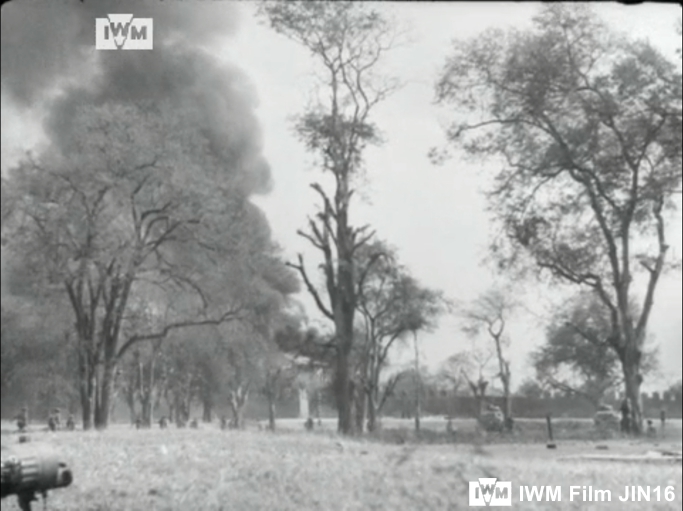
Two Lees move out to the right where they can bring fire to bear on the gateway, direct fire being blocked by the masonry screen. The smoke comes from the wooden structure over the gateway, which was presumably set on fire by the artillery bombardment preceding the attack . The infantry are still moving forward through the trees (left) Note the medium machine gun to the bottom left of the photo, positioned to give covering fire.
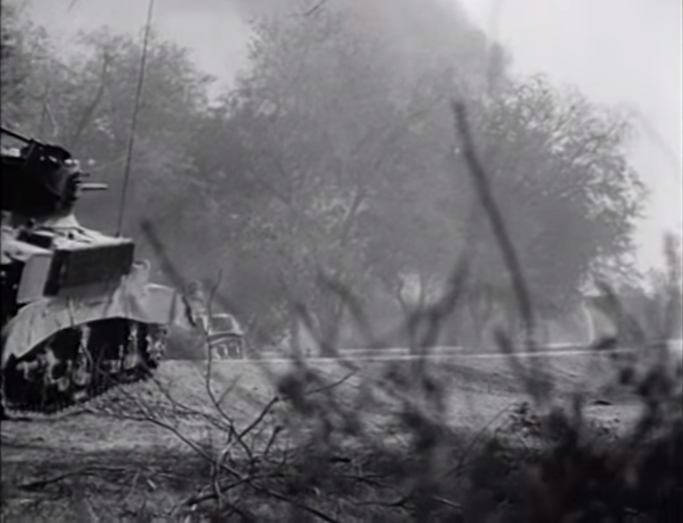
The Lees are followed by Stuart light tanks from 'C' Squadron, 7th Light Cavalry, whose role is to protect the left flank during the attack. (Combat Bulletin #48)

The wooden structure or 'pya-that' above one of the gates of Fort Dufferin on fire. This is possibly the North Gate set ablaze during the attack of 10th March 1945.
Any attempt at movement by 'D' or 'C' Companies was met with fire. Some of the Japanese defenders appeared to be dodging from place to place along the fort wall, despite the tanks firing directly at the fort entrance and the continuous artillery fire landing just inside the fort wall. The tanks also fired smoke in an attempt to cover the infantry. At this point, the Commander of the 19th Indian Infantry Division, Major General T.W. ‘Pete’ Rees, arrived at Battalion Headquarters and conferred over the radio with the Battalion Commanding Officer, temporary Lt. Colonel K.H. Sheikh, who was forward with 'C' Company. Rees then gave orders that the attack should be called off and for the companies to return to their original positions. The artillery laid more smoke and under cover of this, 'D' and 'C' Companies were able to withdraw. Demonstrating extreme bravery, the stretcher bearers set out to retrieve the casualties while under fire and all the dead and wounded, including those on the bridge, were recovered. The casualties suffered by the 8th/12th F.F. Regiment were three dead and 18 wounded. Those killed were Major Kidd, 'D' Company commander; Sepoy (33307) Imam Din; Sepoy (31980) Muhammad Yusuf. There had also been casualties among the men of 'A' Company, 3rd Battalion, 4th Bombay Grenadiers, whose task it was to provide close protection of the tanks. Under the cover of fire from the tanks and of smoke laid down by the artillery, the casualties were eventually evacuated.[19]
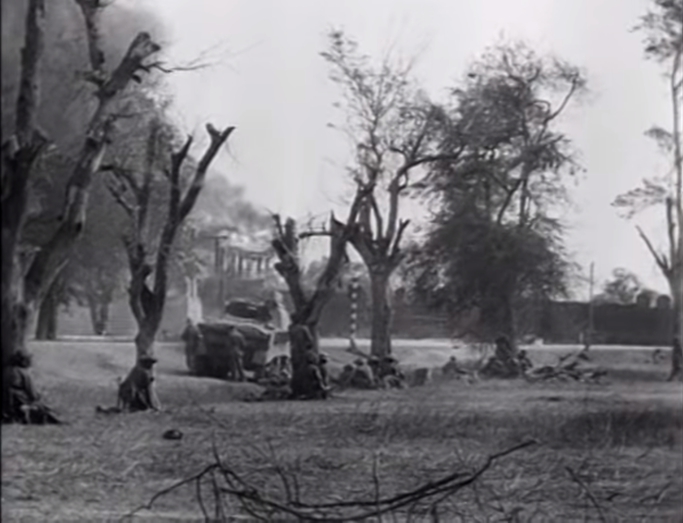
The infantry have now taken cover in a ditch running beside the road leading to the bridge over the moat. A Stuart tank provides covering fire. (Combat Bulletin #48)
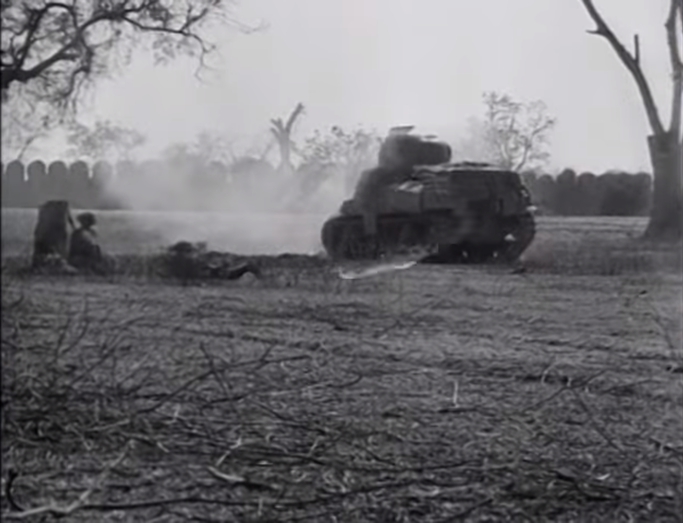
Out on the right, one of the Lees can be seen firing on the gateway and the walls, attempting to suppress the Japanese so the infantry can clear the wire from the bridge. (Combat Bulletin #48)
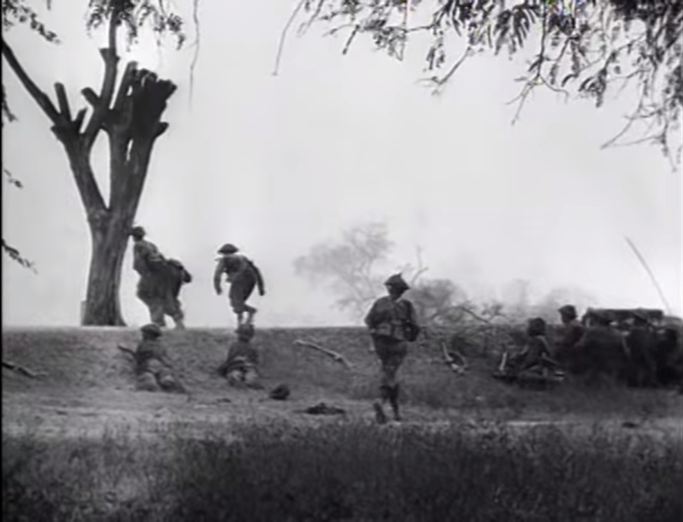
While some troops continue to shelter behind the embankment carrying the road, others rush across the road under the cover of smoke laid by the artillery and mortars. These men appear unarmed and may be involved in the evacuation of casualties from the bridge area. (Combat Bulletin #48)
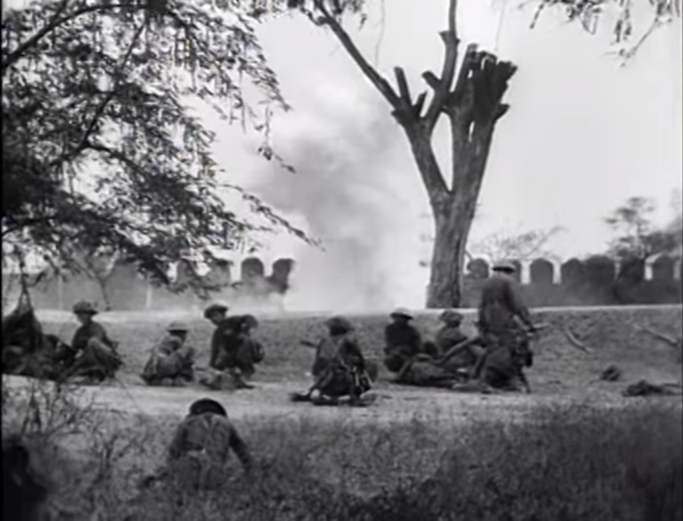
A smoke shell lands between the infantry and the wall of Fort Dufferin. The attack is about to be called off by the commander of the 19th Indian Infantry Division, General Rees. (Combat Bulletin #48)
The narration to the American newsreel asserts that “…several of our tanks are knocked out in the action …”. However, this was not the case. The war diary of the 254th Indian Tank Brigade contains a detailed list of every tank damaged in the fighting between 16th January and 25th March 1945. No damage to any tank of 'C' Squadron 150th Regiment, R.A.C. is recorded as having occurred on 10th March. Two Stuarts belonging to 'C' Squadron, 7th Light Cavalry were destroyed that day, one of which was the result of enemy action. However, this vehicle was lost in support of the clearance operations undertaken by the 2nd Battalion, Royal Berkshire Regiment in the area outside the western walls of the fort and down to the south west corner.[20]
The Japanese continued to bring the 'B' and 'D' Company areas under sniper fire but by 16:30, the Battalion situation had been stabilised. 'B' and 'D' Companies were in their original positions, some way back from the moat to the north of the fort. Battalion Headquarters and 'C' Company were in the area 250 yards to the north west of 'B' and 'D' Companies and 'A' Company was in the area around the Police Station. There was some enemy shelling of the Battalion Headquarters area and three mules were killed and one injured.[21]
The following day, Headquarters 98th Indian Infantry Brigade, forwarded a message to the Battalion from General Rees. The message read: "Kindly express to FFR my admiration of their gallantry today and my regret at their casualties. I have seldom seen such a gallant attack and only wish it could have been favoured with better luck. The rec[overy] of casualties was extremely gallant. I would be grateful if this message could be given to Major Sheikh and all officers and men."[22]
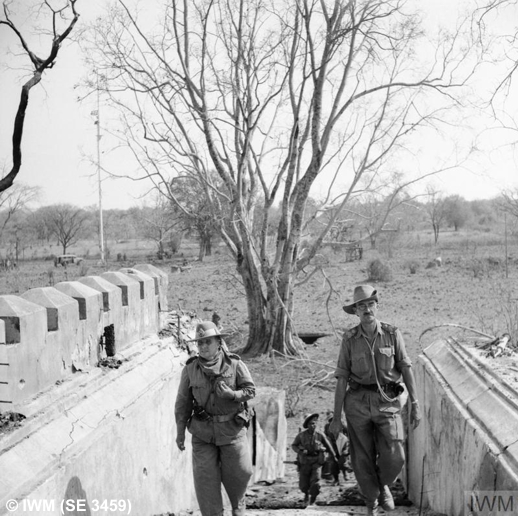
Following the discovery of the escape of the Japanese defenders, Major General T. W. Rees, commanding the 19th Indian Infantry Division (l), accompanied by Brigadier J.G. Flewett, C.O. 64th Indian Infantry Brigade, entering Fort Dufferin, 20th March 1945.

After the British occupation of the fort, a soldier looks out through one of the many breaches made in the walls. In the middle distance the moat can be seen, with Mandalay Hill behind.
22 January 2023
[1] ‘Stiletto Force’ was commanded by Lt. Colonel S. Gardiner and was formed by: the 1st Battalion, 15th Punjab Regiment mounted in lorries; ‘C’ Squadron, 7th Light Cavalry (Stuart light tanks) less one troop; No.1 Troop of Lee tanks of ’C’ Squadron, 150th Regiment, R.A.C.; the 239th Field Battery, 150th Field Regiment, R.A.; a troop of 6-pounder anti-tank guns of the 33rd Anti-Tank Regiment, R.A.; a machine gun company of the 11th Sikh Regiment; two sections of Indian engineers of the 64th (Madras) Field Company, I.E. (“The War against Japan, Vol. IV, The Reconquest of Burma”, Woodburn Kirby, H.M.S.O. (1965); War diary 98th Indian Infantry Brigade, WO 172/7132; War diary 254th Indian Tank Brigade, WO 172/7142).
[2] “Official History of the Indian Armed Forces in the Second World War, 1939-45, The Reconquest of Burma, Vol.2”, Prasad B., Orient Longmans (1959).
[3] Indian Official History
[4] IWM Film, reference JIN 16, accessed June 2018.
[5] IWM Film, JIN 16
[6] Combat Bulletin #48: “Air Support On Western Front Etc, 1945” at the Internet Archive, accessed June 2018; also available (better quality) at “Burma / Myanmar Mandalay Captured Fort Dufferin Siege and Fall March 1945 Footage”, YouTube, accessed June 2018; (best quality) “Combat Bulletin No. 48”, YouTube, go to 21:52 minutes, accessed June 2018
[7] Indian Official History
[8] War diary19th Indian Division, WO 172/6996; War diary 8th/12th F.F. Regiment, WO 172/7737
[9] WO 172/7737
[10] WO 172/7737; War diary 150th Regiment RAC, WO 172/7345; War diary 3rd/4th Bombay Grenadiers, WO 172/770; WO 172/7142; WO 172/6996
[11] 98th Indian Infantry Brigade Operation Order No. 11, dated 9th March 1945, from the Brigade war diary, WO 172/7132; WO 172/6996; War diary 134th Medium Regiment, WO 172/7487
[12] The War against Japan; “Mandalay Palace”, Wikipedia, accessed June 2018
[13] WO 172/7737
[14] WO 172/7737; WO 172/7345; War diary 7th Light Cavalry, WO 172/7348.
[15] WO 172/7737; WO 172/7487; WO 172/7132
[16] The Stuart light tanks of No.3 Troop, ‘C’ Squadron, 7th Light Cavalry were sent to support clearance operations conducted by the 2nd Battalion, Royal Berkshire Regiment outside and to the west of the fort. One of these tanks was lost to enemy action and two men killed (WO 172/7348; War diary 254th Indian Tank Brigade, WO 172/7142).
[17] WO 172/7737; WO 172/7345; WO 172/7348
[18] A more detailed account of the attack from the point of view of the tanks of 'C' Squadron, 150th Regiment, R.A.C., was not possible as the commander of those involved, Lieutenant Sharp, was wounded in action the next day (WO 172/7345).
[19] WO 172/7737; WO 172/7345; WO 172/7142; Commonwealth War Graves Commission
[20] WO 172/7142
[21] WO 172/7737
[22] WO 172/7737
